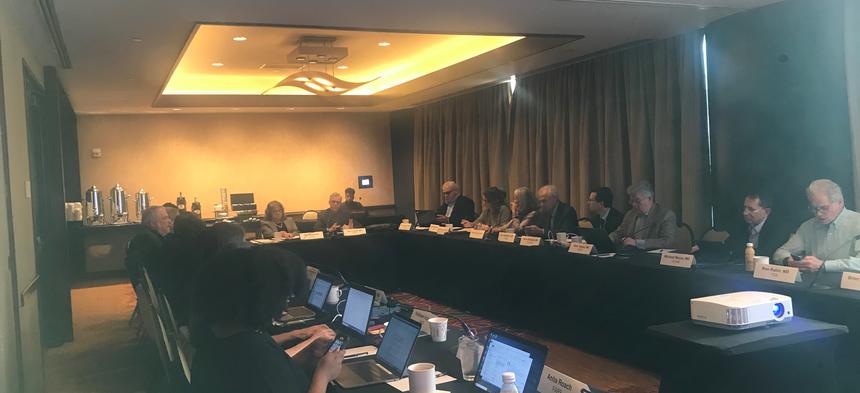Participants At OIT Summit Share Perspectives, Seek Consensus
FARE is taking the lead in educating both physicians and patients about the safety and effectiveness of OIT as a treatment option for some food allergy patients.

Having food allergies is stressful, can be life-threatening and diminishes the quality of life for 32 million Americans. The current standard of care – avoiding problem foods, injecting epinephrine to treat reactions, and visiting the emergency room for follow-up care – all take a physical and emotional toll on food allergy sufferers and their loved ones. The food allergy community deserves more and better options for treatment.
Several forms of immunotherapy are currently being investigated to treat food allergy. Among these, the most widely available treatment for patients living with food allergy is oral immunotherapy (OIT). For many food allergy sufferers, OIT holds promise as a treatment option that can potentially improve their quality of life.
FARE is taking the lead in educating both physicians and patients about the safety and effectiveness of OIT as a treatment option for some food allergy patients. On Nov. 6, health care providers, patient representatives, scientists and food allergy advocates came together in Houston to share their knowledge, experiences and understanding at an OIT Summit.
What Is the Current State of OIT?
Treating food allergy with OIT involves eating the food allergen, starting with a very small amount and progressively increasing the dose, in an effort to retrain the immune system and raise the threshold amount of food protein that results in an allergic reaction. Successful immunotherapy can result in desensitization, in which the patient can eat a significant amount of food allergen without a reaction. Using OIT to develop desensitization to food allergens may significantly reduce food allergy reactions and the need for emergency medications and treatment. Desensitization can be lost if the allergen is not consumed on an ongoing basis.
In some cases, OIT results in sustained unresponsiveness, in which a patient can discontinue doses of the allergen for a period of weeks and still remain able to eat the allergen without reacting. However, available data indicate that for most patients, OIT does not “cure” their food allergy. Adverse effects associated with OIT treatment can be severe, including anaphylaxis and eosinophilic esophagitis.
A small but growing number of food allergy patients have pursued OIT treatment through office-based providers as well as select providers based in academic clinics. The number of providers offering OIT is growing and could increase significantly if the Food and Drug Administration (FDA) approves the peanut OIT product AR101 (brand name Palforzia®). If approved, Palforzia is projected to be available in early 2020. The arrival on the market of an FDA-approved OIT product will likely expand the number of physicians willing to try administering OIT to patients.
Why Hold an OIT Summit?
The FARE OIT Summit brought together a broad spectrum of food allergy stakeholders – including patient advocates, food allergy parents, researchers, healthcare providers, and government and private sector representatives – to develop an OIT consensus path forward for patients and healthcare providers, especially allergists.
FARE recognizes and appreciates that members of the food allergy community hold diverse and sometimes conflicting viewpoints on OIT. To account for these views and to ensure all stakeholders are comfortable with the path forward, FARE seeks to create a robust and transparent process for advancing OIT research and establishing safe and effective OIT options for treating food allergy patients.
What We Learned From the OIT Summit
The OIT Summit’s open, honest, friendly and productive discussion among stakeholders is an important step toward developing safe and effective treatment options for food allergy sufferers. The presentations and dialog called attention to the need for accessible, evidence-based OIT regimens and education, and particularly emphasized the importance of developing effective communication tools to help individuals affected by food allergy collaborate with their physicians in making informed, shared decisions about whether to pursue OIT treatment.
We are pleased with the progress made at the OIT Summit. FARE remains committed to a process that leads to a consensus position on this therapeutic option for patients and that provides appropriate diagnostic and delivery tools for allergists as the optimal providers of this therapy. Specifically, we learned that:
- There is consensus agreement on the need for tools that help patients and their families make informed decisions on whether OIT is right for them. There is also a need for consistent, plain language, and culturally sensitive OIT education vetted by the leading physician and patient organizations and by researchers and clinicians in the medical community.
- Recent meta-analysis data and interpretations of OIT benefits and risks often fail to account for the patient perspective, which must be recognized and heard.
- OIT should be delivered by a trained allergist experienced in diagnosing and treating food allergy.
- The decision to pursue OIT should be a shared decision between the patient, trained allergist and relevant caregivers.
FARE thanks the experts who participated in the OIT Summit and will continue to work with Summit attendees and other key stakeholders to provide optimal care for patients with food allergies, including the appropriate use of OIT, as well as establish safe and consistent protocols for its delivery.


